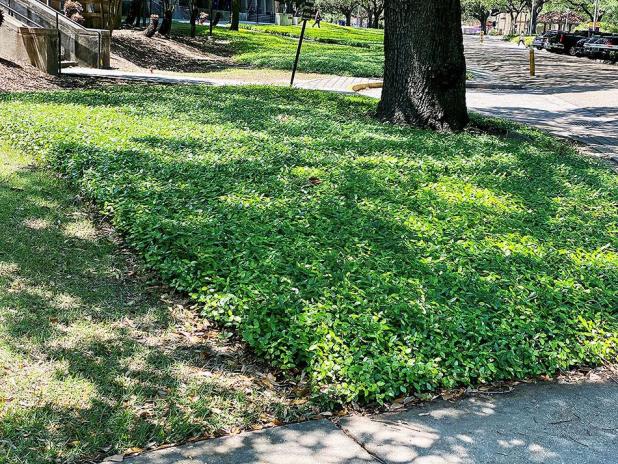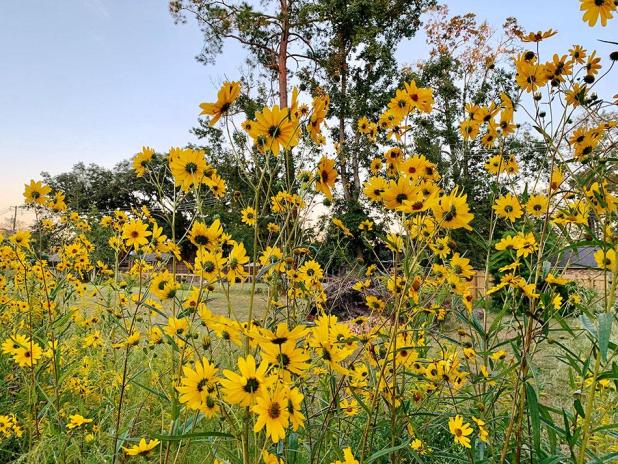
Asiatic jasmine can be used in shaded areas as an alternative to traditional turf grasses.
—LSU AgCenter/Heather Kirk-Ballard

Wildflower meadows bring color, height and pollinators to the landscape.
—LSU AgCenter/Anna Ribbeck
Get It Growing: The allure of alternative lawns
When early settlers migrated westward to establish themselves in North America, they introduced various elements to the world around them. The origins of American lawns can be attributed to landscape designers from England and France. The first lawns in Europe were grassy fields surrounding castles that allowed guards to have a clear view of their surroundings.
Our country’s founding fathers were no exception. As wealthy landowners, Thomas Jefferson and George Washington established lawns on their estates to imitate those European country estates. Since then, the obsession with well-manicured lawns in the United States has been the status quo and the symbol of pride for homeownership.
Lawns provide areas for unobstructed views and recreation activities such as playing ball, picnicking and lounging. With enough space, you can even enjoy the all-important sports that Americans hold dear such as golf, football and soccer. They have a place in our landscapes and our hearts.
However, lawns can require relentless upkeep such as mowing, weeding, dethatching and aerating — and after one of the driest summers on record here in Louisiana, I should point out that grass is the most irrigated plant in the United States. According to the U.S. Environmental Protection Agency, landscape irrigation is estimated to account for nearly one-third of all residential water use, with lawns accounting for the majority of the use of water due to their shallow root systems.
Furthermore, we must consider the chemicals commonly applied to our lawns such as fertilizers and pesticides (including herbicides and insecticides), which can leach into our water supply during heavy rainfall. Lawns offer limited habitat possibilities, and many of the grasses commonly used in typical home lawns are nonnative to the United States.
Another concern relates to the use of gasoline-powered lawn equipment, such as mowers, trimmers, dethatching equipment and aerators, which emit gases contributing to climate change. It’s important to note that this discussion is not intended to cast a negative light on turf grass and lawns, but rather to highlight how our quest for pristine lawns can have environmental consequences.
By writing about lawns and their alternatives, I aim to inspire homeowners to reconsider their concept of the American lawn. The good news is you don’t have to eliminate your lawn. You can start by downsizing and considering alternatives to what plants we utilize to create our lawns.
Alternative lawns are becoming increasingly popular as ecofriendly and low-maintenance landscaping options. They often consist of plants other than traditional grasses and can include a variety of groundcovers and low-growing plants.
Groundcovers can be a good solution because they naturally spread and often don’t grow tall enough to require mowing on a regular basis. With their spreading habit, they outcompete weeds — another huge headache with lawns consisting of turf grass species such as St. Augustine, centipede, zoysia and bermuda. Native groundcovers are an excellent choice in addition to several nonnative plants that tend to be more readily available at retail garden centers.
Some examples of groundcovers that can be used as turf grass alternatives are creeping herbs such as thyme and oregano, creeping phlox, creeping Jenny, yarrow, clovers and many types of mosses.
Other common lawn replacements include groundcovers that tolerate more shade such as liriope, creeping lily turf, monkey grass, Asiatic jasmine, and both Algerian and English ivy.
For part to full sun areas in the landscape you can utilize a host of sedums, low-growing junipers, dwarf gardenias, dwarf lantanas and perennial verbenas.
Additionally, you can replace traditional lawns with wildflower meadows. Wildflowers add some height, color and, of course, attract pollinators. This can add a great deal of diversity to your landscape.
There are many more plants that can be considered as alternatives. You could replace large areas of turf grasses with more landscape plants such as annuals, perennials, vines, shrubs and trees.
When selecting plants for an alternative lawn, it’s important to consider factors like your climate, soil type, sun exposure and the intended use of the space. Some plants are better suited to specific conditions, so it’s essential to choose the right groundcover for your particular landscape.
Additionally, combining various groundcovers can create a more diverse and visually appealing alternative lawn.
